Law enforcement in India


Law enforcement in India is imperative to keep justice and order in the nation. Indian law is enforced by a number of agencies. India has a multi-layered law enforcement structure with both federal and state/union territory level agencies, including specialized ones with specific jurisdictions.[1] Unlike many federal nations, the constitution of India delegates the maintenance of law and order primarily to the states and territories.[2]
Under the Constitution, police is a subject governed by states. Therefore, each of the 28 states have their own police forces. The centre is also allowed to maintain its own police forces to assist the states with ensuring law and order. Therefore, it maintains seven central armed police forces and some other central police organisations for specialised tasks such as intelligence gathering, investigation, research and record-keeping, and training.[1]
At the federal level, some of India's Central Armed Police Forces are part of the Ministry of Home Affairs and support the states. Larger cities have their own police forces under their respective state police (except the Kolkata Police that is autonomous and reports to state's Home Department). All senior officers in the state police forces and federal agencies are members of the Indian Police Service (IPS).[3]India has some special tactical forces both on the federal and state level to deal with terrorist attacks and counter insurgencies like Mumbai Police Quick Response Team, National Security Guard, Anti-Terrorism Squad, Delhi Police SWAT, Special Operations Group (Jammu and Kashmir), etc.
Central agencies
[edit]
The Central Government has established a number of Central Police Organisations (CPOs) to fulfill diverse law enforcement and security roles. These CPOs can be broadly categorized into two groups:[3]
Central Armed Police Forces (CAPFs): These are armed police forces responsible for internal security, counter-insurgency operations, and border guarding. They include organizations such as the Assam Rifles, Central Reserve Police Force (CRPF), Border Security Force (BSF), Central Industrial Security Force (CISF), Indo-Tibetan Border Police (ITBP), and Sashastra Seema Bal (SSB).
Central Police Organisations (CPOs): This group comprises organizations that perform specialized functions such as police research and development, criminal investigation, intelligence gathering, police training and forensic science. These include:
- Bureau of Police Research and Development (BPR&D): Conducts research and development in police science and technology.
- Central Bureau of Investigation (CBI): Investigates serious crimes of national importance, corruption and economic crimes.
- Directorate of Coordination of Police Wireless (DCPW): Coordinates wireless communication among police forces.
- Intelligence Bureau (IB): Collects intelligence to counter internal security threats.
- National Investigation Agency (NIA): specialised counter-terrorism law enforcement agency.
- Narcotics Control Bureau (NCB): Investigation and intelligence of narcotics crimes.
- National Crime Records Bureau (NCRB): Maintains a national database of crime statistics.
- National Institute of Criminology and Forensic Science (NICFS): Provides training and research in criminology and forensic science.
- National Disaster Response Force (NDRF): Responsible for disaster management and emergency services in times of calamities.
In addition, there are Police Training institutions, such as the National Police Academy (NPA) and the North Eastern Police Academy (NEPA). There is a Railway Protection Force (RPF) that functions under the control of the Ministry of Railways.
Some intelligence and investigating agencies under the Ministry of Finance also do policing work. They are involved in collecting intelligence and investigating economic offences pertaining to customs, excise, income tax, foreign exchange, money laundering, and narcotics smuggling. Some of these are the Central Economic Intelligence Bureau, Directorate General of Revenue Intelligence, Directorate of Enforcement, Financial Intelligence Unit, Directorate General of GST Intelligence, and Directorate General of Income Tax (Investigation).
Most federal law-enforcement agencies are under the Ministry of Home Affairs. The head of each agency is typically an IPS officer. The constitution assigns responsibility for maintaining law and order and policing to the states and territories, and almost all routine policing—including the apprehension of criminals—is done by state-level police forces. The constitution also permits the central government to participate in police operations and organization by authorizing the creation of the Indian Police Service.

Central police forces can assist a state's police force if requested by a state government. During the 1975–77 Emergency, the constitution was amended on 1 February 1976 to permit the central government to deploy its armed police forces without state permission. The amendment was unpopular, and use of the central police forces was controversial. After the Emergency was lifted, the constitution was again amended in December 1978 to restore the status quo.
Ministry of Home Affairs
[edit]The principal national ministry concerned with law enforcement is the Ministry of Home Affairs (MHA), which supervises a large number of government functions and agencies operated and administered by the central government. The ministry is concerned with matters pertaining to the maintenance of public peace and order, the staffing and administration of the public services, delineation of internal boundaries, and the administration of union territories.
In addition to controlling the IPS, the Ministry of Home Affairs maintains several agencies and organizations dealing with police and security. Police forces in the union territories are under the MHA. The Minister of Home Affairs is the cabinet minister responsible for the ministry; the Home Secretary, an Indian Administrative Service (IAS) officer, is the ministry's administrative head.
Central Armed Police Forces
[edit]Border Security Force
[edit]The Border Security Force (BSF) is responsible for policing India's land borders in peacetime and preventing trans-border crimes. A central police force under the Ministry of Home Affairs, its duties include VIP security, election supervision, guarding vital installations and counter-naxal operations.
The Indo-Pakistani War of 1965, which highlighted the inadequacy of the existing border-management system, led to the formation of the Border Security Force as a unified central armed police force mandated with guarding India's boundary with Pakistan. The BSF's policing capability was used in the Indo-Pakistani War of 1971, against the Pakistani Armed Forces, in areas which were the least threatened. During wartime or when ordered by the central government, the BSF is commanded by the Indian Army; BSF troops participated in the 1971 Battle of Longewala in this capacity. After the 1971 war (which led to the creation of Bangladesh), responsibility for policing the border with Bangladesh was assigned to the force.
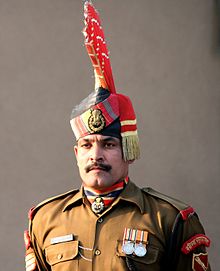
Originally charged with guarding India's external borders, the BSF has been tasked with counter-insurgency and counter-terrorism operations. When insurgency in Jammu and Kashmir broke out in 1989 and the Jammu and Kashmir state police and the thinly-deployed Central Reserve Police Force (CRPF) needed extra force to cope with spiraling violence, the central government deployed the BSF to Jammu and Kashmir to combat Kashmiri militants.
BSF operates a Tear-Smoke Unit at its academy in Gwalior, Madhya Pradesh, which supplies tear gas and smoke shells for riot prevention to all state police forces. It operates dog squads, and runs the National Dog Training and Research Centre. The BSF, one of several Indian police forces which have its own air and water wings, provides helicopter, dog and other support services to the state police.
Central Industrial Security Force
[edit]The Central Industrial Security Force's (CISF) primary task is to provide industrial security.[4] It guards industrial installations nationwide which are owned by the central government, secures seaports and airports, and provides security for certain non-governmental organizations. The CISF provides security for nuclear-power plants, space installations, mints, oil fields and refineries, heavy-engineering and steel plants, barrages, fertilizer units, hydroelectric and thermal power stations, and other installations partially (or wholly) run by the government.[5]
Central Reserve Police Force
[edit]The Central Reserve Police Force's (CRPF) main objective is to assist states and union territories' law-enforcement agencies in maintaining law and order and containing insurgency. It is deployed as an anti-terrorist unit in several regions, and operates abroad as part of United Nations peacekeeping missions.[6]
Indo-Tibetan Border Police
[edit]The 90,000-member Indo-Tibetan Border Police (ITBP) is responsible for security along the 2,115-kilometre (1,314 mi) Indo-Tibetan border and its surrounding areas. ITBP personnel are trained in maintaining law and order, military tactics, jungle warfare, counter-insurgency, and internal security. They were also deployed to Indian diplomatic missions located in Afghanistan.[7]
National Security Guard
[edit]The National Security Guard (NSG) is a commando unit originally created for counter-terrorism and hostage-rescue missions. Founded in 1986, it is popularly known as the "Black Cats" for its uniform. Like most military and elite-security units in India, it avoids the media and the Indian public is largely unaware of its capabilities and operational details.
The NSG draws its core members from the Indian Army, and the balance is support staff from other central police units. An NSG team and a transport aircraft is stationed at Indira Gandhi International Airport in New Delhi, ready to deploy in 30 minutes.
Sashastra Seema Bal
[edit]Sashastra Seema Bal (SSB), founded in 1963, is deployed at the Indo-Nepal and Indo-Bhutan borders. SSB, with over 82,000 personnel, is trained in maintaining law and order, military tactics, jungle warfare, counter-insurgency, and internal security. Its personnel are also deployed to the Intelligence Bureau (IB), Research and Analysis Wing (R&AW), Special Protection Group (SPG), National Security Guard. Officers begin as an assistant commandant (equivalent to deputy superintendent of police on a state force), and retire with the rank of inspector general (IG).
Special Protection Group
[edit]The Special Protection Group (SPG), the central government's executive protection agency, is responsible for the protection of the Prime Minister of India and their immediate family. The force was established in 1985, after the assassination of Indira Gandhi. It provides daily, round-the-clock security throughout India to the present Prime Minister and his family.
Central investigation and intelligence institutions
[edit]Central Bureau of Investigation
[edit]The Central Bureau of Investigation (CBI) is India's premier investigative agency, responsible for a wide variety of criminal and national security matters. Often cited as established with the Delhi Special Police Establishment Act, 1946, it was formed by the central government (which controls the Delhi police) with a resolution. Its constitutionality was questioned in the Gauhati High Court Narendra Kumar vs Union of India case on the basis that all areas of policing are exclusive to state governments, and the CBI is a central-government agency. The court ruled that despite the lack of legislation, the CBI is an authorized agency of the central government for national policing. Its ruling was upheld by the Supreme Court of India, which cited the CBI's national importance.
The bureau is controlled by the Department of Personnel and Training in the Ministry of Personnel, Public Grievances and Pensions of the government of India, usually headed by the Prime Minister as the Minister of Personnel, Public Grievances and Pensions. India's Interpol unit, the CBI draws its personnel from IPS officers throughout the country. Specializing in crimes involving high-ranking government officials and politicians, the CBI has also accepted other criminal cases because of media and public pressure (usually due to local-police investigative incompetence).
Income Tax Department
[edit]
The Income Tax Department (ITD) is India's premier financial agency, responsible for a wide variety of financial and fiscal matters. The department is controlled by the Department of Revenue in the Ministry of Finance, headed by a minister who reports directly to the prime minister. The Central Board of Direct Taxes (CBDT) is also part of the Department of Revenue. It provides input for policy and planning of direct taxes, and is responsible for the administration of direct-tax laws through the Income Tax Department. The CBDT operates in accordance with the Central Board of Revenue Act, 1963. The board members, in their ex officio capacity, are also a division of the ministry dealing with matters relating to the levy and collection of taxes, tax evasion and revenue intelligence. It is India's official Financial Action Task Force on Money Laundering (FATF) unit. The Income Tax Department draws its staff from Indian Revenue Service officers nationwide, and is responsible for the investigation of economic crimes and tax evasion. Some special agents and agents can carry firearms.[8]
The Directorate of Criminal Investigation (DCI) is headed by the Director General of Intelligence (Income Tax), which was created to address cross-border black money. The DCI conducts unobtrusive investigations of "persons and transactions suspected to be involved in criminal activities having cross-border, inter-state or international ramifications, that pose a threat to national security and are punishable under the direct tax laws."[8]
Commissioners of the ITD's intelligence directorate posted in cities such as Delhi, Chandigarh, Jaipur, Ahmedabad, Mumbai, Chennai, Kolkata, and Lucknow will also conduct criminal investigations for the DCI. The ITD's intelligence wing oversees the Central Information Branch (CIB), which has a repository of data on taxpayers' financial transactions.
Directorate of Revenue Intelligence
[edit]The Directorate of Revenue Intelligence (DRI) is an intelligence-based organization responsible for the coordination of India's anti-smuggling efforts. Officers are drawn from the Indian Revenue Service and Group B[clarification needed] of the Central Board of Indirect Taxes and Customs.
Central Economic Intelligence Bureau
[edit]The Central Economic Intelligence Bureau (CEIB) is the intelligence agency responsible for gathering information and monitoring the economic and financial sectors for economic offenses and warfare.
The Directorate General of GST Intelligence (DGGI), formerly the Directorate General of Central Excise Intelligence (DGCEI), is an intelligence-based organization responsible for tax evasion cases related to central excise duty and Goods and Service Tax (GST). Officers are drawn from the Indian Revenue Service and Group B of the Central Board of Indirect Taxes and Customs.
National Investigation Agency
[edit]The National Investigation Agency (NIA), the central agency combatting terrorism, can deal with interstate terror-related crimes without permission from the states. The National Investigation Agency Bill 2008, creating the agency, was moved in Parliament by the Home Minister on 16 December 2008.[9][10][11] The NIA was created in response to the 2008 Mumbai attacks as a central counter-terrorism agency. Also dealing with drug trafficking and currency counterfeiting, it draws its officers from the IRS and the Indian Police Service.
Narcotics Control Bureau
[edit]The Narcotics Control Bureau is responsible for anti-narcotics operations nationwide, checking the spread of contraband and the cultivation of drugs. Officers in the bureau are drawn from the IPS and IRS.
Bureau of Police Research and Development
[edit]The Bureau of Police Research and Development (BPRD) was established on 28 August 1970 to modernize the police forces. It researches police issues, including training and the introduction of technology at the central and state levels.
National Crime Records Bureau
[edit]In 1979, the National Police Commission recommended the creation of agency to maintain criminal records and a database shareable at the federal and state levels. The National Crime Records Bureau (NCRB) was established by combining the Directorate of Coordination Police Computers, the Central Fingerprint Bureau, the Data Section of Coordination Division of the Central Bureau of Investigation, and the Statistical Section of the Bureau of Police Research and Development.
Central forensic institutions
[edit]Central Forensic Science Laboratory
[edit]The Central Forensic Science Laboratory (CFSL), a wing of the Ministry of Home Affairs, houses the only DNA repository in South and Southeast Asia. There are seven central forensic laboratories: in Hyderabad, Kolkata, Bhopal, Chandigarh, Pune, Guwahati and New Delhi. CFSL Hyderabad is a centre of excellence in chemical sciences, CFSL Kolkata in biological sciences, and CFSL Chandigarh in the physical sciences. The laboratories are primarily controlled by the ministry's Directorate of Forensic Science (DFS); the New Delhi lab is under the Central Bureau of Investigation, and investigates cases on its behalf.
National Institute of Criminology and Forensic Science
[edit]The National Institute of Criminology and Forensic Science (NICFS) was established on 4 January 1972 at the recommendation of a committee appointed by the University Grants Commission (UGC). In September 1979, the institute became a department of the Ministry of Home Affairs with a full-time director. It is headed by senior Indian Police Service officers. The institute trains in cybercrime investigations, and researches aspects of criminology and forensics (including cyber forensics). It is listed as a science and technology organization by the Department of Science and Technology.
State police
[edit]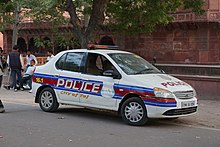
State police forces are organized under the purview of the state governments, with each state and union territory maintaining its own police force. The overarching authority for police matters lies with the state's home department, led by a additional chief secretary or principal secretary, also known as the home secretary, typically an IAS officer. The state police force is headed by a Director General of Police (DGP), who is typically an Indian Police Service (IPS) officer.
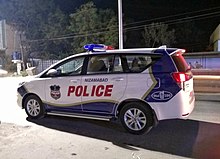
The Police Act of 1861 provides the foundational framework for the organization and functioning of police forces in India. While there may be variations in equipment and resources among different state police forces, their organizational structure and operational patterns are generally similar.
Below the DGP, the police force is divided into police zones, ranges, districts, subdivisions, and police stations. Inspectors General (IGPs) head the police zones, while Deputy Inspectors General (DIGs) lead the police ranges. Superintendents of Police (SPs) command the district police headquarters and oversee subordinate units. Apart from the law and order wing, each state police consists of special wings such as the criminal investigations department, the intelligence wing, police training wing and the state armed police, headed by senior officers.
Police in the states and union territories are assisted by units of volunteer Home Guards under guidelines formulated by the Ministry of Home Affairs.
In most states and territories, police forces are divided into civil (unarmed) police and armed police contingents. Civil police staff police stations, conduct investigations, answer routine complaints, perform traffic duties, and patrol the streets. They usually carry lathis: bamboo staffs, weighted (or tipped) with iron.

Armed police are divided into two groups: district armed police/district armed reserve (DAR) and the State Armed Police Force or Provincial Armed Constabulary. District armed police are organized like an army infantry battalion. Assigned to police stations, they perform guard and escort duties. The district armed reserve police (DAR) functions under the respective district police units. States which maintain armed contingents use them as an emergency reserve strike force. The units are organized as a mobile armed force under state control or, in the case of district armed police (who are not as well equipped), as a force directed by district superintendents and generally used for riot control.
The Provincial Armed Constabulary or State Armed Police is an armed reserve maintained at key locations in some states and activated on orders from the deputy inspector general and higher-level authorities. Armed constabulary are not usually in contact with the public unless they are assigned to VIP duty or maintaining order during fairs, festivals, athletic events, elections, and natural disasters. They may be sent to quell outbreaks of student or labour unrest, organized crime, and communal riots; to maintain key guard posts, and to participate in anti-terrorism operations. Depending on the assignment, the Provincial Armed Constabulary may only carry lathis.
Senior police officers answer to the police chain of command, and respond to the general direction of designated civilian officials. In the municipal force, the chain of command runs to the state home secretary rather than the district superintendent or district officials.
Recruits receive about ₹ 30,000 per month. Opportunities for promotion are limited because of the system of horizontal entry into higher grades.[clarification needed] A 2016 article on the Maharashtra state police describes why reform is needed.[12]
Women have entered into the higher echelons of Indian police in greater numbers since the late 1980s, primarily through the Indian Police Service system. Female officers were first used in 1972, and a number of women hold key positions in state police organizations. Their absolute numbers, however, are small. Uniformed and undercover women police officers have been deployed in New Delhi as the Anti-Eve Teasing Squad, which combats the sexual harassment of women ("Eves"). Several women-only police stations have been established in Tamil Nadu to handle sex crimes against women.
Uniforms
[edit]
Uniforms of state and local police vary by grade, region, and type of duty. The main service uniform for state police is khaki. Some cities, such as Kolkata, have white uniforms. Headgear differs by rank and state; officers usually wear a peaked cap, and constables wear berets or sidecaps.[13] Branches such as the Crime Branch, Special Branch do not have a uniform; business dress (shirt, tie, blazer, etc.) is worn with a badge. Special-service armed police have tactical uniforms in accordance with their function, and traffic police generally wear a white uniform.[citation needed]
Organisation
[edit]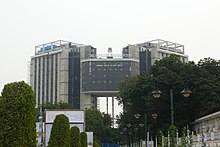
The state police is headed by an IPS officer with the rank of director general of police (DGP), assisted by two (or more) additional directors general of police (ADGs). Other DGP rank officers head autonomous bodies not controlled by the DGP, such as the police recruitment board, fire service and police training, vigilance, anti-corruption bureau, prisons department, police housing society, police welfare bureau, etc. State forces are organised into zones, which consist of two (or more) ranges. Important zones are headed by an additional director general of police (ADGP), and other zones are headed by an inspector-general of police (IG). Ranges consist of several districts. Important ranges are headed by an IG, and other ranges are headed by a DIG.
Important districts are headed by a senior superintendent of police (SSP), and other districts are headed by a superintendent of police (SP). If an SSP is heading the district, they are assisted by two (or more) SPs. If an SP is heading the district, they are generally assisted by one or two) Additional SPs. Each district is divided into sub-divisions or circles, under a deputy superintendent of police (DSP). Each sub-division consists of several police stations commanded by an inspector of police, who is assisted by sub-inspectors (SIs) and assistant sub-inspectors (ASIs). In rural areas, a sub-inspector is in charge of a police station; whereas the police circle inspector supervise the functions of the police stations. sub-inspectors (and higher) can file a charge sheet in court.
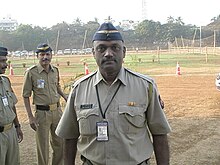
District SPs are not empowered as executive magistrates. The district magistrate (DM, an IAS officer) exercises these powers, which include promulgating Section 144 of the Code of Criminal Procedure (CrPC) and issuing arms licenses.
Other than the district police forces, there can be various other departments under the state police, such as Criminal Investigation Department (CID), Economic Offences Wing (EOW), Telecom, VIP Security, Traffic police, Government Railway Police (GRP), Anti-Corruption Organization, State Armed Police Forces, Anti Terrorism Squad (ATS), Special Task Force (STF), State Crime Records Bureau (SCRB), Forensic Science Laboratory (FSL), State Special Branch, Coastal Security Police etc.[14]
Government Railway Police
[edit]The Government Railway Police (GRP) is the security police force that is responsible for policing on the railway stations and trains of Indian Railways. Its duties correspond to those of the District Police in the areas under their jurisdiction, but only on railway property. While Railway Protection Force (RPF) comes under Ministry of Railways, Government of India, GRP comes under the respective state police or UT police.[15][16]
Police Commissionerates
[edit]Some major metropolitan cities use the police commissionerate system (like Delhi, Mumbai, Chennai, Kolkata, Bengaluru, Hyderabad, Ahmedabad, Lucknow, Jaipur etc.), headed by a police commissioner. Demand for this system is increasing as it gives police a free hand to act freely and take control of any situation. 68 large cities and suburban areas currently have this system in India.
Even during the colonial era, the presidency towns of Calcutta, Bombay and Madras had commissionerate system.
Reporting to the Police Commissioner (CP) are the Joint Police Commissioner (Joint CPs), Deputy Commissioner of Police (DCPs) and Assistant Commissioner of Police (ACPs). Commissioners of police and their deputies are empowered as executive magistrates to enforce Section 144 of the CrPC and issue arms licenses.
Police commissionerates are subordinate to the state police except for the Kolkata Police, which independently reports to the Department of Home of Government of West Bengal.
Traffic police
[edit]
Highway police and traffic police in small towns are under the state police; traffic police in cities are under the metropolitan and state police.
Traffic police maintain a smooth traffic flow and stop offenders.
Highway police secure the highways and catch speeders. Accidents, registrations, and vehicle data are checked by traffic police.
State Armed Police Forces
[edit]The State Armed Police Forces provide a state with policing in particularly violent or serious situations, such as combating banditry and Naxalites. Like the Central Armed Police Forces, they are known unofficially as paramilitary forces. Each state police force maintains an armed force, with names such as Provincial Armed Constabulary (PAC) and Special Armed Police, which is responsible for emergencies and crowd control. They are generally activated on orders from a deputy inspector general or higher-level authorities. List of the State Armed Police Forces are here in below.
State agencies
[edit]In addition to state police forces, there are several other law enforcement agencies under the control of state governments in India. These agencies are specialized in their respective areas of law enforcement. Here are some examples:
State Excise Departments
[edit]The State Excise Department is responsible for enforcing laws related to the production, sale, and consumption of alcoholic beverages and other controlled substances within the state. They regulate and monitor the licensing, taxation, and distribution of such substances.[17] They are responsible for the enforcement of Narcotic Drugs and Psychotropic Substances Act (NDPS) and various state laws relating to narcotics. Here is a list of some State Excise Departments in India:
- Andhra Pradesh Prohibition and Excise Department
- Kerala Excise
- Telangana Excise
- Department of Excise & Taxation, Haryana
- Karnataka Excise
- Tamil Nadu Prohibition and Excise Department
State Forest Departments
[edit]The State Forest Department is tasked with protecting and conserving the state's forests and wildlife. They enforce forest laws, prevent illegal logging, poaching, and smuggling of wildlife, and promote environmental conservation.[18]
- Andhra Pradesh Forest Department
- Kerala Forest and Wildlife Department
- Tamil Nadu Forest Department
- Maharashtra Forest Department
- Karnataka Forest Service
- Forests Department, Haryana
- Department of Forest and Wildlife (Punjab)
- Telangana Forest Department
- Uttarakhand Forest Department
- Environment and Forests Department (Assam)
- Environment and Forests Department (Arunachal Pradesh)
State Transport Departments
[edit]State Motor Vehicles Departments (MVDs) or Transport Departments are government agencies responsible for the administration and regulation of motor vehicles and road transport within each state in India. These departments are primarily focused on implementing and enforcing the provisions of the Motor Vehicles Act, 1988, and other relevant laws pertaining to motor vehicles. They are tasked with the enforcement of Motor Vehicles Act and state rules. Each state has its own State Motor Vehicles Department, often headed by a Commissioner of Transport or a similar administrative position.[19]
- Ministry of Transport (Andhra Pradesh)
- Kerala Motor Vehicles Department
- Department of Transport (Tamil Nadu)
Anti-corruption Bureau
[edit]Vigilance Departments or Anti-Corruption Bureaus are specialized law enforcement agencies under state governments, that are responsible for combating corruption and promoting integrity within the government and public administration. These departments primarily focus on preventing, detecting, and investigating corruption-related offenses involving public officials.[20]
- Anti-Corruption Bureau (Andhra Pradesh)
- Kerala Vigilance and Anti-Corruption Bureau (VACB)
- Anti-Corruption Bureau (Maharashtra) (ACB)
Jurisdiction
[edit]Police in India primarily belong to the State List of the Constitution and, therefore, Policing and various Police matters falls into the jurisdiction of the respective State Governments.
Federal
[edit]Central Bureau of Investigation (CBI)
[edit]The Central Bureau of Investigation (CBI) is a premier investigating agency of the Government of India. It derives its power to investigate from the Delhi Special Police Establishment Act (DSPE), 1946. The Jurisdiction of CBI extends across India, but requires prior consent from state governments for investigations within their territories.[21]
Executive officers of the CBI, of the rank of Sub-Inspector and above, are empowered to exercise all the powers of a police officer in charge of a police station for the purpose of investigation in the concerned area.
The CBI can investigate crimes committed against central government employees, such as bribery, corruption, or misconduct. The CBI has the authority to investigate cases with inter-state or international implications, including organized crime, terrorism, human trafficking, money laundering, and other transnational offenses. The CBI can investigate offenses listed in the DSPE Act, such as those under the Prevention of Corruption Act and other central laws. The CBI can also investigate cases referred to it by courts or the central government or the state governments.
The CBI requires the consent of state governments to investigate cases within their territories. This consent can be either general or specific. While general consent allows the CBI to investigate cases without seeking permission for each case, specific consent is required for individual cases. As of 2024, 8 states have withdrawn general consent to the CBI, limiting its ability to freely investigate cases in these states. These states include Punjab, Jharkhand, Kerala, West Bengal, Telangana, Meghalaya, Karnataka and Tamil Nadu.[22][23]
National Investigation Agency (NIA)
[edit]The National Investigation Agency (NIA) is a specialised counter-terrorism law enforcement agency in India. Unlike the CBI, it has nationwide jurisdiction, meaning it can investigate cases across the country without requiring the consent of individual state governments. It functions under the Union Ministry of Home Affairs.
The NIA's jurisdiction extends to offenses that threaten India's sovereignty, security, and integrity, as well as those that impact India's relations with other nations. The agency is empowered to investigate various crimes, including terrorism, bomb blasts, aircraft and ship hijackings, human trafficking, counterfeiting, and cyberterrorism. The 2019 amendment to the NIA Act further expanded its jurisdiction to cover a wider range of offenses.[24]
Enforcement Directorate (ED)
[edit]The Enforcement Directorate (ED) is responsible for enforcing economic laws and combating financial crimes. The ED has the power to investigate and prosecute cases related to money laundering, including tracing and attaching assets derived from criminal activities under Prevention of Money Laundering Act, 2002. The ED enforces Foreign Exchange Management Act and regulations and can investigate and impose penalties for violations of these rules. The ED's jurisdiction extends across India and it has powers to investigation and arrest, prosecution, attachment of property and confiscation of property.[25]
Railway Protection Force (RPF)
[edit]RPF is a security force of Indian Railways that functions under the Ministry of Railways. RPF is primarily responsible for the protection and security of railway property, passengers and passenger areas.
It has the power to search, arrest, enquire, and prosecute offenses committed under the Railway Property (Unlawful Possession) Act 1966 and the Railways Act, 1989. The general policing powers on railway stations and trains lie with the respective State's Railway Police, known as Government Railway Police (GRP). The GRP has significant powers such as maintaining order, investigating crimes, and preventing crime within the railway stations and trains.
If the RPF encounters a fight or any other criminal activity on a moving train or railway premises, they typically hand over the accused individuals to the GRP for further investigation and legal action. This is because the GRP has primary jurisdiction over general law and order matters within railway premises.[26]
State
[edit]State governments in India have primary jurisdiction over law enforcement, including maintaining law and order, investigating crimes, prosecuting offenders, and managing prisons.[1]
State Police
[edit]Each state in India has its own state police force. At the most basic level, law enforcement is carried out by police stations. These stations are responsible for maintaining law and order, preventing and detecting crimes, and patrolling their designated areas.
Role of women
[edit]In 1972, Kiran Bedi became the first female The Law and Order wing of the state police carried out primary law enforcement such as maintaining order, patrolling, crime prevention and detection, etc. For these police stations are constituted, and responsible for routine law enforcement. The police stations has jurisdictionional area, and each headed by a Station House Officer (SHO), who is incharge of the police station. An officer in charge of a police station, often referred to as a Station House Officer (SHO), possesses significant powers under the Code of Criminal Procedure (CrPC) and the Indian Penal Code (IPC). State police departments in India have specialized units to handle specific types of crimes. These units include the Crime Branch/CID for investigating complex crimes, the ATS for investigation of terrorism counter-terrorism, and the EOW for economic offenses. Other specialized units may include Cyber Crime Cell for cybercrimes, and Women's Police Stations for crimes against women and children.Indian Police Service officer. Twenty years later, Asha Sinha was the first female commandant of the paramilitary forces. Kanchan Chaudhary Bhattacharya was the first female director general of police in a state when she was appointed DGP of the Uttarakhand Police. In 2018, IPS Officer Archana Ramasundram became the first female paramilitary DGP (Sashastra Seema Bal).[27]

Women had previously been limited to supervisory roles in the Central Armed Police Forces.[28] The parliamentary Committee on Empowerment of Women recommended greater roles for women in the CAPF. In accordance with this recommendation, the Ministry of Home Affairs mandated preferential treatment for women in paramilitary constabularies and later declared that women could be combat officers in all five Central Armed Police Forces.[28] The Union Home Minister announced that female representation in the CRPF and Central Industrial Security Force would be 15 percent and five percent in the Border Security Force, Indo-Tibetan Border Police and Sashastra Seema Bal.[29] On 5 January 2016, it was decided that 33 percent of CRPF and CISF constabulary posts would be reserved for women in the CRPF and the CISF, and 14-15 percent in the BSF, SSB and ITBP.[citation needed]
Forest Service
[edit]The maintenance of Forest and Forest land falls within the ambit of respective Forest services of state who is headed by Indian Forest Service (IFoS) Officer. The main mandate of the service is the implementation of the National Forest Policy in order to ensure the ecological stability of the country through the protection and participatory sustainable management of natural resources. An IFoS officer is wholly independent of the district administration and exercises administrative, judicial and financial powers in his own domain. Positions in state forest department, such as District/Divisional Forest Officer (DFO), Conservator of Forests (CF), Chief Conservator of Forests (CCF) and Principal Chief Conservator of Forests (PCCF) etc., are held only by IFoS officers. The highest ranking IFS official in each state is the Head of Forest Forces (HoFF). Apart from this Forest are regularly patrolled by Forest Rangers although they don't have arrest powers but they are task in detecting and stopping smugglers of Forest produce and poacher. Upon detection the accused/s are handed over to police for further process. The duties of the Forest Service are not confined to stopping of crimes but also have responsibility to develop tourism and also to look after villages falling under Forest land. Forest Services role came to forefront due to smuggling and poaching activities of Verrappan.
There are reports of forest guards being overwhelmed by the animals and poachers and smuggler due to lack of equipment or obsolete equipment. Forest Guards have been reported not able to fight back since they have been under heavy restrictions of usage of weapons and even if available they are no match to automatic weapons employed by the poachers and smugglers.[30][31]
Although due to nature of the duty Forest guards is a male dominated profession more and more women have been recruited in forest services. This women guards are performing duty akin to their male counterparts. The role of women in Forest service is highlighted in Discovery Channel India's four part documentary series "Lion Queens of India" based on forest guards of Gir wildlife sanctuary, Gujarat.[32]
The Forest Department although greatly restricted in carrying firearm, These firearms are only for protection of self and accompanying forest personnels including temporary workers, and the conditions of use of firearms of all descriptions are very rigidly laid out and the use of every cartridge, even for training purposes, has to be immediately accounted for to the department as well as to the Executive Magistrate having jurisdiction and the police. In case of any human casualties arising out of use of these firearms the Executive Magistrate having jurisdiction conducts enquiry and only when he finds that the use of fire arms was unauthorised, illegal, or excessive, further action is taken by the police. Injuries or death of wild animals of all descriptions has to be reported to the Chief Wildlife Warden of the state without delay first over wireless and then in writing.[citation needed] The Forest guards are generally issued .303 Lee Enfield SMLE and 12 Bore double barrel shotgun or single barrel shotgun while under special circumstance L1A1 Self-Loading Rifle are also issued.
The Forest Department are usually travel in Mahindra Jeep or other off-road vehicle, the Forest Department also travel on motorcycles especially Royal Enfield Motorcycles and Hero Splendor.
The Forest guards have uniforms similar to that of police with women also being given option of Salwar kameez.
Selection and training
[edit]The recruitment process differs by position, and direct entry (where an applicant does not have to start at the lowest level) is possible. Educational requirements increase for higher posts.
Assistant superintendents of police (ASP) are recruited annually by the independent Union Public Service Commission by competitive examination, and are appointed to the Indian Police Service. The IPS officers are then assigned to a state/union territory police force. Trainee officers undergo 44 weeks of initial training, which includes invited lawyers and management consultants. At the end of their probation, they have several weeks of orientation at the state police academy.
Non-managerial positions are selected by the state (or central) government, and are trained at police recruit schools. The length of training for inspectors is about a year; for constables, it is nearly nine months. School training staff is drawn from the police force. Police are trained in basic law, self-protection, weapons handling and other skills at recruit stations. Superior recruits receive special training.
Recruitment for state police is conducted by state police recruitment boards or state public service commission. Eligibility standards are set by the central government, depending on state demographics.
Transport
[edit]| Vehicle | Origin | Use | Image |
|---|---|---|---|
| Royal Enfield 350/500 | India | Used for patrolling and as intercepters, Acrobatic team, convoy motorcycle. | 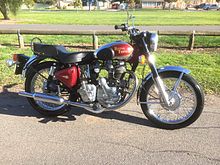
|
| Harley-Davidson Street 750 | USA | Exclusively used by Gujarat Police & Kolkata Police for piloting VIP convoys | 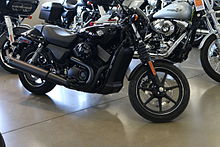
|
| Bajaj Pulsar 150 | India | Used mainly by traffic police and for responding to Calls | 
|
| Hero Splendor | India | Not the most common police vehicle but mainly used by police of rural regions. | 
|
| TVS Apache | India | Used by traffic cops as intercepters and also for patrolling. | 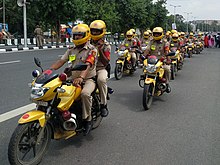
|
| Tata Safari Storme | India | Used by tactical police forces (such as SWAT), senior bureaucrats, and as police responding Units [Dial-100] in Madhya Pradesh. | 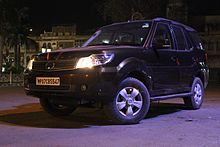
|
| Mahindra Scorpio | India | Used by almost all Police Departments in India, by special forces, senior bureaucrats, income-tax and central excise officers. It is also used in escorts. | 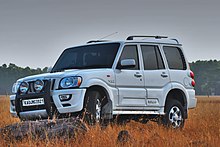 |
| Mahindra Major jeep | India | Mainstay of all state police, being phased out from service. It was once a face for Indian Police, after being replaced by Mahindra Bolero. |  |
| Mahindra Rakshak | India | Used as an armoured personnel carrier, riot control | 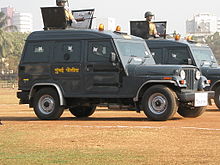
|
| Tata Vajra | India | Used as an armoured personnel carrier, riot control | |
| Mahindra XUV500 | India | Used by investigation cells of police, Special Forces, senior bureaucrats, VIP escorts, and income-tax officers. | |
| Isuzu D-max | Japan, India | Used by special forces of Nagaland and Karnataka Police for ops. | 
|
| Ashok Leyland MBPV | India | Used by Punjab Police SWAT Team and Kerala Police Thunderbolts (SWAT Team) | 
|
| Mahindra Marksman | India | Used by special forces like Riot control units of Delhi Police and Mumbai police, Karnataka police |

|
| Tata LATC | India | Used by special forces like Riot control units of Delhi Police and Mumbai police, Karnataka police |
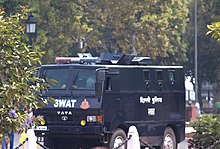
|
| Tata Nexon | India | Electric version being employed by Motor vehicles department of State of Kerala | 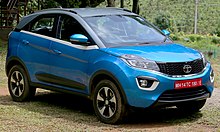
|
| Maruti Suzuki SX4 | India, Japan | Used by judges, ministers, and Telecom Regulatory Authority of India advisors and as Escorts of Members of The Parliament, Delhi police | 
|
| Maruti Suzuki Ertiga | India | Used in Bangalore City Police's mobile beat/patrol fleet Hoysala and their all-women patrol called Pink Hosyala. | |
| Force Gurkha | India | Used exclusively by Kerala Police and Kerala Forest Department for patrolling rough and bad terrain, hill station and rural areas and naxal affected regions. | |
| Toyota Innova | Japan, India | Used by police as investigator's vehicle, also used by senior bureaucrats, income-tax and central excise officers, and as highway patrol units. | 
|
| Chevrolet Tavera | India, US | It is used by police in all sorts of activities. Also used by senior bureaucrats and as highway patrol units and also are used for customs raids.
|
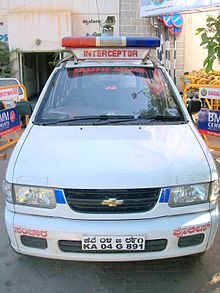
|
| Tata Xenon | India | used by NSG, Indian Army, and Several police Departments like Lucknow police, Mumbai police, Madhya Pradesh police, etc. | 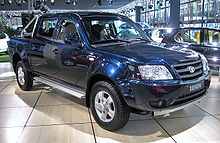
|
| Toyota Fortuner | Japan, India | Used by ministers and high-ranking law-enforcement officials of NIA, CBI, and IB. It has been also deployed by ITBP on China border. | 
|
| Mahindra TUV 300 | India | Used as patrol vehicle. It is used by Tamil Nadu, Kerala, Mumbai, Lucknow and Andhra Pradesh police. | |
| Honda Civic | Japan, India | Used by judges, ministers, and Income Tax Appellate Tribunal members. | 
|
| Toyota Corolla | Japan, India | Used by judges, ministers, and Telecom Regulatory Authority of India advisors, Tamil Nadu police | 
|
| Tata Sumo | India | It was once the face of Indian police forces and was known and used for its tough terrain capabilities and is spacious. | 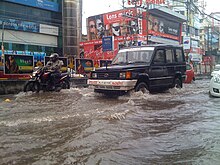
|
| Tata Indigo CS | India | Squad car, senior bureaucrats such as the commissioners of Income Tax, Police, Customs and Central Excise | 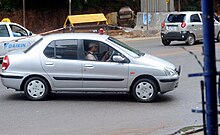
|
| Chevrolet Captiva | India, US | Used by ministers and MPs. | 
|
| Hindustan Ambassador | India | Used by senior bureaucrats, police, income-tax, central excise and customs officers and ministers, most of Indian police | 
|
| Ford Endeavor | India, US | Used by ministers and some Police forces Like Lucknow police, Mumbai police, Para-military, etc., for heavy-duty usage. | 
|
| Mitsubishi Pajero | Japan, India | Used for VIP Security duties, etc. | 
|
| Maruti Gypsy | Japan, India | Used by Delhi Police, Tamil Nadu Police, Uttar Pradesh Police and the Indian Army as squad cars and responding units. | 
|
| Mahindra Bolero | India | Squad car and common police vehicle of Kerala, Telangana, Gujarat state polices, central excise-and-customs and state excise department officers | 
|
| Hyundai Accent | Korea, India | Squad car, additional commissioners of income tax, and police. Used by Police Departments Like Tamil Nadu, Kerala and the state of AP | 
|
| Toyota Hilux | Japan, India | Used by Punjab Police SSF | |
| Tata 407 | India | Variants of this model used in riot control, armored personnel carrier, prison van, police personnel carrier | 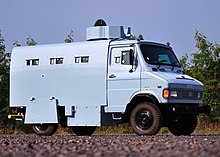
|
| Tata bus | India | Prison van and for transporting Police personnel, most of Indian police | 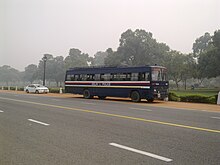
|
| Renault Sherpa | France | Used by CISF and NSG | 
|
| Motor patrol boats | India | Used by Marine Police | 
|
| Suzuki Jimni | India | Used by Kerala Police for patrolling in the hilly areas.[33] | |
| Mahindra Thar | India | Used by Kerala Police for patrolling in rural areas.[34] |
Unlike other countries, Indian state police forces rely on SUVs. The Mahindra Commander Jeep was the most used car by the police in India until some time ago. This jeep was practical for patrolling rural areas and had a large seating capacity. Now with the arrival of new generation SUVs they are being phased out. SUVs are known for their ability to handle a variety of terrain. Instead of the old Mahindra Jeep, the police are relying on the Mahindra Bolero. Most state police departments in India now use sport utility vehicles like the Mahindra Bolero, Tata Sumo, Maruti Gypsy, Tata Safari, Mahindra Scorpio, Mahindra Thar, etc. In cities, compact utility vehicles (compact SUVs) such as the Mahindra TUV300 and Ford EcoSport, etc. multi-purpose vehicles (MPVs) such as the Toyota Innova and Maruti Suzuki Ertiga, and sedans such as the Toyota Etios and Maruti Suzuki Swift Dzire are used. In some states, like Kerala, vehicles such as the Force Gurkha, the Isuzu DMax, the Mitsubishi Pajero, etc. are used for special purposes.[35][36][37][38][39]
Minivans are used by police in cities such as Delhi, Mumbai, Bangalore and Lucknow where the Chevrolet Tavera (Delhi, Kochi, Kozhikode and Thiruvananthapuram), Toyota Qualis (Mumbai, Delhi and Chennai) and Maruti Suzuki Ertiga (Bangalore, Lucknow and Pune) are extensively used. Although most cities use SUVs and minivans, Chennai has adopted sedans such as the Hyundai Accent; Kolkata has adopted the Tata Indigo. In Kerala cities such as Thiruvananthapuram, Kochi and Kozhikode, the Pink Police Patrol (to protect women) uses the Toyota Etios, Maruti Suzuki Swift DZire, Volkswagen Vento and Police Control Room Units uses Mahindra TUV and new gen Mahindra Thar as first responding vehicle. Mumbai Police and Lucknow Police use Mahindra TUV for Pink Police.
Depending upon the state, police vehicles may have revolving lights, strobes, or light bars and public announcement systems, surveillance cameras. A modernization drive has ensured that vehicles are equipped with two-way radios in communication with a central control room. Highway police vehicles generally have radar equipment, breath analyzers, and emergency first aid kits. For traffic regulation and city patrol, motorcycles are also used; most was the Indian version of the Royal Enfield Bullet, but the Bajaj Pulsar and TVS Apache are also used.
Weapons and equipment
[edit]
Weapons and equipment vary from state to state and agency to agency. Standard equipment for a constable on the beat is the lathi, or long baton—generally made of bamboo, but currently also made of polymer. Riot police have other equipment, including tear gas and tasers.
Although police constables do not generally carry firearms on regular duty, they are available at police stations. Officers at and above the rank of sub-inspector or head constable are authorized to carry a side arm, generally a Pistol Auto 9mm 1A or a Glock 17. Officers always carry side arms. Traffic police officers have fine books and other equipment.
Firearms previously stocked at police stations included .303 Lee–Enfield rifles (now replaced), 7.62 1A self-loading rifles and SAF Carbine 2A1s, which have been replaced by AK-47 and INSAS rifles. The Ordnance Factory Board is a supplier of arms, ammunition, uniforms, bullet-proof vehicles, and mine-protected vehicles to the police. Only a station officer can allow the use of reserve guns in emergencies. During public unrest, protests or possible terrorist attacks, police are equipped by the state (or central) government.
Special units at the state and federal level have automatic weapons, such as the AK-47, AKM and INSAS assault rifles and Bren guns. Special-forces and SWAT units use Heckler & Koch MP5s, Brügger & Thomet MP9s, AK-103s, M4A1 Carbines and others. Bulletproof jackets are generally not worn by state police, although special units carry tactical vests, gear, and weapons according to function.
| Name | Weapon | Type | Caliber | Origin | Note |
|---|---|---|---|---|---|
| Handguns | |||||
| Beretta 92 | 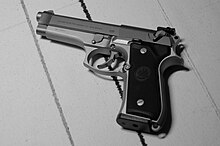
|
Semi-automatic pistol | 9×19mm Parabellum | Italy | Standard issue firearm |
| Pistol Auto 9mm 1A | 
|
Semi-automatic pistol | 9×19mm Parabellum | India | Standard issue firearm |
| Glock 17 | 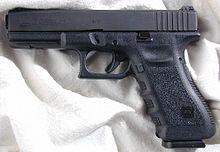
|
Semi-automatic pistol | 9×19mm Parabellum | Austria | Standard Issue Firearm |
| IOF .32 revolver | 
|
Revolver | 7.65mm x 23mm | India | Standard issue firearm |
| CornerShot | 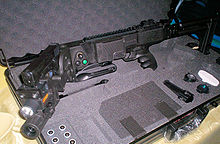
|
weapon accessory | Israel and India | Used by SWAT Team. | |
| Shotgun | |||||
| OFB pump action Shotgun | 
|
Pump action | 12-gauge shotgun | India | Used mostly by prison service and Forest Departments |
| Sub-Machine Gun | |||||
| SAF Carbine 2A1 | 
|
Submachine gun | 9×19mm Parabellum | India | Phasing out and being replaced by MSMC |
| Heckler & Koch MP5 | 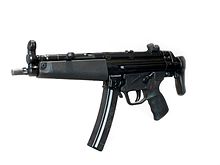
|
Submachine gun | 9×19mm Parabellum | Germany | Used mainly by Police SWAT and CAPFs |
| Brügger & Thomet MP9 | Submachine gun | 9×19mm Parabellum | Switzerland | Used mainly by Police SWAT | |
| Sten Sub Machine | 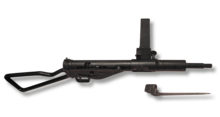
|
Submachine gun | 9×19mm Parabellum | UK | Being phased out and replaced by MSMC |
| Modern Sub Machine Carbine | 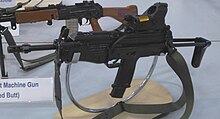
|
Submachine gun | 9×19mm Parabellum | India | Replacing all Sten Sub Machine and SAF Carbine 2A1 |
| Assault Rifle/ Battle Rifles | |||||
| Ishapore 2A1 rifle | bolt-action | 7.62 NATO | India | Being phased out, mainly retain for ceremonial purpose, still employed by Forest Departments | |
| 315" Sporting Rifle | 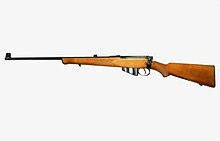
|
bolt-action | 8 mm (.315") | India | Mainly employed by Forest Departments |
| 12 Bore Double barrel shotgun | 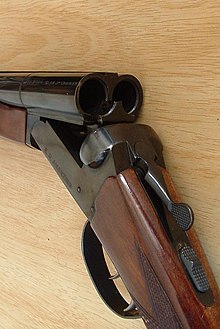
|
Double barrel shotgun | 12-gauge | India | Mainly employed by Forest Departments |
| SG 552 | Assault rifle | 5.56×45mm NATO | Switzerland | Being used by Mumbai police's Force One Commando and Punjab Police SWAT Team | |
| L1A1 Self-Loading Rifle | 
|
Semi-automatic rifle | 7.62×51mm NATO | UK | Being phased out |
| AKM | 
|
Assault Rifle | 7.62×39mm | Russia | |
| 1B1 INSAS | 
|
Assault Rifle | 5.56×45mm NATO | India | Mainstay of police force |
| Amogh carbine | 
|
Assault Rifle | 5.56×45mm NATO | India | Used by Manipur police and Uttar Pradesh police. |
| Excalibur rifle | 
|
Assault Rifle | 5.56×45mm NATO | India | Used by Manipur police,Karnataka police,Assam police and West Bengal police. |
| AK-103 | 
|
Assault rifle | 7.62×39mm | Russia | Used by Mizoram Police and Mumbai Police. |
| Colt M4 | 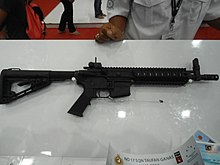
|
Assault rifle | 5.56 NATO | USA | Used by Mizoram Police and Mumbai Police. |
| Light Machine Gun | |||||
| GUN MACHINE 7.62MM IA | 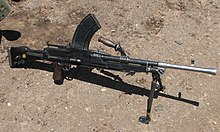
|
Light machine Gun | 7.62 x 51 mm NATO | India | Being phased out |
| INSAS LMG | 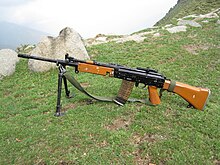
|
Light machine Gun | 5.56×45mm NATO | India | Being replaced |
| Sniper Rifles | |||||
| M107 | 
|
Sniper Rifle | 416 Barrett | USA | Used by Mumbai Police's Force One Commandos |
| PSG1 | 
|
Sniper Rifle | 7.62×51mm NATO | Germany | Used by OCTOPUS and Greyhounds |
Special units
[edit]- CoBRA - The Commando Battalion for Resolute Action, abbreviated as CoBRA, is a specialized force under the Central Reserve Police Force (CRPF). It is tasked with combating left-wing extremism and insurgents, primarily engaged in jungle warfare operations.
- Anti-Terrorism Squad (ATS) - Anti-Terrorism Squads (ATS) are specialized units of state police forces tasked with combating terrorism, handling counter-terror operations, and investigating terrorism-related crimes. Maharashtra State Police was the first police department in the country to set up an ATS unit. Each ATS unit collaborates with central agencies like the National Investigation Agency (NIA) and the Intelligence Bureau (IB) to handle threats and ensure national security.
Mukhbir
[edit]
Informers (mukhbir) provide information for financial compensation. Police agencies budget for their mukhbirs because they are "the eyes and ears of police", and help resolve cases. In 2012, the Delhi Police budgeted ₹ 40 lakh (₹ 4 million) to pay their mukhbir (₹ 2,000 per inspector).[40]
Police reforms in India
[edit]The landmark judgment in Prakash Singh v. Union of India marked a significant step towards police reforms in India. The Supreme Court issued several directives to the Central and State Governments to improve the efficiency and accountability of the police force. Following are the key directives of the SC;[41]
- State Security Commission (SSC)
Establishment of a State Security Commission to ensure the independence of the police and prevent undue political interference.
The Commission should be modeled after recommendations from the National Human Rights Commission, Reberio Committee, or Sorabjee Committee.
- Selection and Tenure of DGP:
- Selection of the Director General of Police (DGP) from among the three most senior officers empanelled by the Union Public Service Commission.
- A minimum tenure of two years for the DGP, irrespective of their date of superannuation.
- Tenure of Operational Police Officers:
- A minimum tenure of two years for police officers on operational duties, such as Inspectors General (IGPs) incharge of police zones, Deputy Inspectors General (DIGs) incharge of police ranges, Superintendents of Police (SPs) incharge of police districts, and Station House Officers (SHOs) incharge of police stations.
- Separation of Investigation and Law and Order:
- Separation of investigative and law and order functions of police at the police station level.
- Police Establishment Board:
- Establishment of a Police Establishment Board at the State level to handle transfers, postings, promotions, and other service-related matters of officers up to the rank of Deputy Superintendent of Police.
- Police Complaint Authority
- Establishment of Police Complaints Authorities at the State and District levels to investigate complaints against police officers.
- National Security Commission:
- Establishment of a National Security Commission at the Union level to select and place chiefs of Central Police Organizations (CPOs) and ensure their minimum tenure of two years.
Public perception
[edit]In general, police in India lack public trust and are not viewed as legitimate authorities.[42] People generally do not go to the police for help if given the choice, and often specifically take pains to avoid them.[42] Oftentimes, when people do go to the police, it is "only for instrumental purposes, such as obtaining a First Information Report (FIR) as documentary evidence to be used to achieve some end".[42] People expect the police be unhelpful at best, and corrupt or brutal "little tyrants" at worst.[42] Former Union Home Minister P. Chidambaram characterised the police constable as "the most reviled public servant in India."[42] Even police officers themselves often lack faith in the institution, as illustrated by an apocryphal story popular among officers where "a self-styled 'honest cop'" asks a group of fellow officers if they would trust their coworkers to take care of a family member in trouble — to which none of them said yes.[42]
Scholars usually tend to attribute the police's poor reputation in India to two main factors.[42] First, the police as an institution in India was first developed by the British as an instrument of control.[42] The 1861 Police Act, which remains "the institutional bedrock across the country", configured the police to focus less on public service and crime investigation, and more on "coercive order keeping and crowd pacification".[42] Second, the police in postcolonial India are affected by the same corruption and abuse of power that has plagued the government in general.[42] Police have historically been known to apply excessive force, extortion, and arbitrary and often discriminatory use of authority.[42]
See also
[edit]- Sheriffs of India
- Indian Armed Forces
- Judiciary of India
- Indian Penal Code
- Indian criminal law
- Government of India
- Mass surveillance in India
- List of Indian intelligence agencies
- National Counter Terrorism Centre
- Police Complaints Authority (India)
- Indian Police Foundation and Institute
- List of cases of police brutality in India
- Crime and Criminal Tracking Network and Systems
- List of countries and dependencies by number of police officers
References
[edit]- ^ a b c "Discussion Papers: Police Reforms in India". PRS Legislative Research. Retrieved 27 November 2024.
 This article incorporates text from this source, which is available under the CC BY 4.0 license.
This article incorporates text from this source, which is available under the CC BY 4.0 license.
- ^ "Chidambaram was unsure of NIA's constitutionality". 19 March 2011.
- ^ a b "Indian Police Portal".
- ^ "Role of CISF in the internal security of the country". MorungExpress. Retrieved 29 March 2021.
- ^ "Section 10 in the Central Industrial Security Force Act, 1968". Indian Kanoon. Retrieved 29 March 2021.
- ^ "CRPF contingent evacuated as situation worsens in Libya: Sushma Swaraj". India Today. 7 April 2019. Retrieved 29 March 2021.
- ^ "India sending 35 ITBP commandos to guard Afghanistan missions". The Economic Times. PTI. 27 October 2015. Retrieved 29 March 2021.
- ^ a b "Tax evasion cases: I-T 'special agents' to carry arms". The Indian Express. 7 September 2011. Archived from the original on 14 March 2016. Retrieved 27 July 2019.
- ^ "Finally, govt clears central terror agency, tougher laws". The Times of India. 16 December 2008. Archived from the original on 14 August 2019. Retrieved 26 July 2019.
- ^ "Cabinet clears bill to set up federal probe agency". Archived from the original on 8 May 2013. Retrieved 25 May 2009.
- ^ "Govt tables bill to set up National Investigation Agency". The Times of India. 16 December 2008. Archived from the original on 11 August 2019. Retrieved 26 July 2019.
- ^ Balachandran, Vappala (17 July 2016). "Fixing Mumbai: Free the police". The Hindu.
- ^ "1The Indian Police Service (Uniform) Rules, 1954". Archived from the original on 8 February 2014. Retrieved 31 August 2015.
- ^ "Organisational Setup of Uttar Pradesh Police". Uttar Pradesh Police. Retrieved 15 May 2021.
- ^ "MoS Railways dubs Railway Protection Force as 'toothless', demands more power for it". economictimes.indiatimes.com. Press Trust of India. Retrieved 12 June 2019.
- ^ Bibek Debroy. "Lesser-known facts about GRP and RPF". Business Standard. Retrieved 16 May 2021.
- ^ "Excise Directorate | Govt of West Bengal".
- ^ "About Us". Kerala Forest and Wildlife Department. Archived from the original on 29 September 2023.
- ^ "About the Department | Motor Vehicle Department".
- ^ "Introduction | Anti Corruption Bureau | India". Retrieved 21 June 2023.
- ^ "Delhi Special Police Establishment Act (DSPE)- CBI".
- ^ "As Karnataka withdraws general consent to CBI, which other states have taken this route". The Indian Express. 27 September 2024. Retrieved 28 November 2024.
- ^ "10 states withdraw general consent to CBI to investigate cases: Centre". The Economic Times. 20 December 2023. ISSN 0013-0389. Retrieved 28 November 2024.
- ^ "National Investigation Agency Act, 2008" (PDF).
- ^ "Two years after it upheld PMLA, Supreme Court rulings rein in powers of ED by adding safeguards". The Indian Express. 29 August 2024. Retrieved 29 November 2024.
- ^ "RPF". rpf.indianrailways.gov.in. Retrieved 30 November 2024.
- ^ "First ever woman chief of SSB retires; Rajni Kant Mishra takes charge". The Economic Times. 14 July 2018. Archived from the original on 10 February 2018. Retrieved 12 March 2019.
- ^ a b "Government allows women to be combat officers in all Central Armed Police Forces". The Economic Times. 11 July 2018. Archived from the original on 24 February 2019. Retrieved 11 March 2019.
- ^ "Women quota in CRPF, CISF to be made 15 per cent". telegraphindia.com. Archived from the original on 3 April 2019. Retrieved 11 March 2019.
- ^ Azad, Shivani (22 October 2019). "Forest guard dies in tiger attack in Corbett, third such death this year in reserve". The Times of India. Retrieved 18 April 2020.
- ^ "हिंदी खबर, Latest News in Hindi, हिंदी समाचार, ताजा खबर". Patrika News (in Hindi). 11 November 2014. Retrieved 18 April 2020.
- ^ "Meet The Shernis : India's Only Female Forest Guards Stationed at Gir". Cocktail Zindagi. 9 August 2017. Retrieved 18 April 2020.
- ^ "Maruti Suzuki Jimny Officially Added To Kerala Police Fleet". Times Now. 14 October 2024. Retrieved 16 October 2024.
- ^ Daily, Keralakaumudi. "315 new vehicles for state police at a cost of Rs 28 crore; flagged off by Chief Minister". Keralakaumudi Daily. Retrieved 16 October 2024.
- ^ Tomorrow, India (15 August 2016). "Kerala Police launch patrol vehicles for women's safety". IndiaTomorrow. Retrieved 7 May 2023.
- ^ "'Amma Patrol' in Chennai launched to ensure safety of women and girls". The News Minute. 27 August 2019. Retrieved 7 May 2023.
- ^ "Stalin flags off 93 new patrol vehicles for Chennai police". DT next. 10 June 2022. Retrieved 7 May 2023.
- ^ Daily, Keralakaumudi. "315 new vehicles for state police at a cost of Rs 28 crore; flagged off by Chief Minister". Keralakaumudi Daily. Retrieved 7 May 2023.
- ^ "Police to get 17 new patrol vehicles in Coimbatore". The Times of India. 7 February 2022. ISSN 0971-8257. Retrieved 7 May 2023.
- ^ Delhi cops seek bigger fund to pay informers Archived 19 January 2019 at the Wayback Machine, Hindustan Times, 16 May 2012.
- ^ "Prakash Singh vs Union of India and ors, Supreme Court directives" (PDF). Mizoram Police.
- ^ a b c d e f g h i j k Jauregui, Beatrice (2013). "Beatings, Beacons, and Big Men: Police Disempowerment and Delegitimation in India". Law & Social Inquiry. 38 (3): 643–69. doi:10.1111/lsi.12030. JSTOR 24545738. S2CID 145487010. Retrieved 17 July 2021.
External links
[edit] Media related to Law enforcement in India at Wikimedia Commons
Media related to Law enforcement in India at Wikimedia Commons

